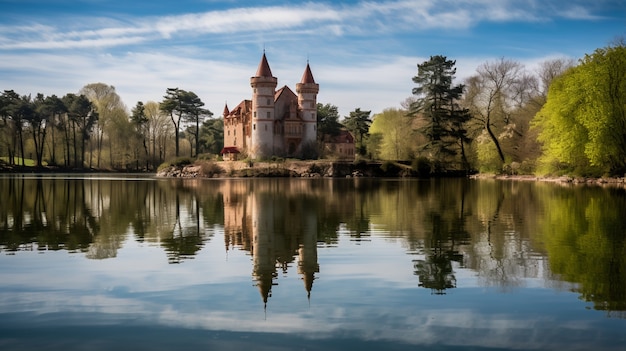
If you’re exploring the South West of Germany, you’ll find an array of palaces to choose from, each with its own stunning interiors and beautiful gardens. Here are four must-see palaces that range from opulent splendor to monastic simplicity: Schwetzingen, Weikersheim, Ludwigsburg, and Bebenhausen.
This region is renowned for its castles and palaces, showcasing the wealth and significance of Baden-Württemberg’s rulers. With over 50 castles, palaces, monasteries, and gardens, including some UNESCO World Heritage sites, every visit offers a glimpse into the grandeur and affluence that built them.
**Schwetzingen Palace**
Originally a small castle built in the 14th century, Schwetzingen Palace was significantly expanded in the 17th century by Prince Elector Johann Wilhelm. The formal gardens, commissioned by Prince Elector Carl Theodor, feature geometric parterres and fountains, with avenues of trees stretching into the distance. As a former summer residence, it’s conveniently close to Heidelberg and Mannheim, making it easy to visit all three in a few days.
The extensive gardens include an English-style landscape garden and Turkish gardens with an ornamental mosque, which has never served a religious purpose. Scattered sculptures and small buildings, like the temple of Apollo, add to the charm. Inside, you can admire 18th and early 19th-century furniture and visit the Rococo Theatre, designed for the Elector’s entertainment.
The Bath House, created by Elector Carl Theodor, served as a private retreat and is adorned with classical frescoes. The marble bathtub in the Elector’s bathroom, with warm water piped from the kitchen, epitomizes the luxurious lifestyle of the time.
**Ludwigsburg Residential Palace**
Just a 30-minute drive from Stuttgart, Ludwigsburg Residential Palace was built by the Dukes of Württemberg. It uniquely showcases architectural and decorative styles from Baroque to Rococo to Neoclassical periods. Originally a hunting lodge, it was expanded in 1733 into a magnificent residence.
The palace houses museums, original decor apartments, rare furniture, and paintings. The private apartments of Duke Herzog Carl Eugen of Württemberg, restored in 2004, display sumptuous Rococo style. Other attractions include the Ceramics Museum, Fashion Museum, Baroque Gallery, and the Palace Theatre.
The Marble Hall, remodeled by King Frederick I in 1815, features a frescoed ceiling and opulent yet elegant gold decorations. The Kinderreich interactive museum allows children to experience court life from 300 years ago through hands-on exhibits and costumes.
**Schloss Weikersheim**
Located in the scenic Tauber Valley, Schloss Weikersheim was built in the 16th century by Count Wolfgang of Hohenlohe. This Renaissance-style palace, later developed by Count Carl Ludwig of Hohenlohe, features a garden with statues and an orangery. The Knight’s Hall, dating back to 1600, is famous for its paneled ceiling depicting hunting scenes and exotic wildlife.
One of the palace’s most elaborate rooms is the Mirror Cabinet, created in 1718 for Princess Elisabeth Friederike Sophie. This small room, with walls covered in red silk damask, displays the princess’s collection of East-Asian porcelain and other precious items.
The palace gardens include a balustrade with comical dwarf figures created in 1712 by Johann Jakob Sommer, serving as caricatures of the royal household.
**Bebenhausen Monastery**
Set in the rolling hills of the Schönbuch nature reserve, Bebenhausen Monastery is one of Southern Germany’s best-preserved Cistercian abbeys. Founded in the 12th century, it became one of the wealthiest monasteries in the region. After the Reformation, it was converted into a royal hunting palace.
A guided tour reveals the lives of the monks and schoolboys who lived here. Key features include the Summer Refectory with its late Gothic style and the winter refectory, later used by King Karl I. The royal couple Wilhelm II and Charlotte updated their apartments here, with luxurious features like the queen’s modern bathroom, still stylish by today’s standards.
For more detailed information on visiting these palaces, you can check their respective websites or look for guidebooks like the DK Eyewitness Germany Travel Guide.